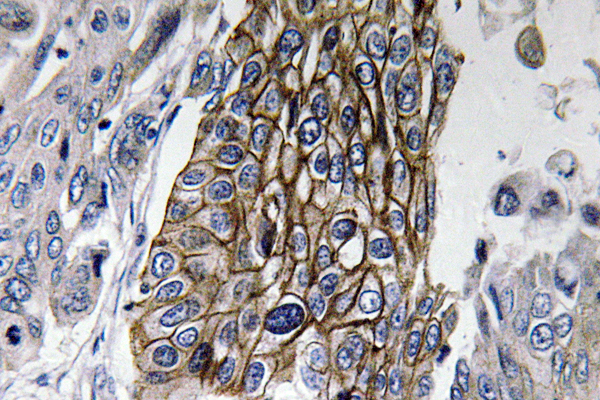产品名称
Connexin-32 Rabbit Polyclonal Antibody
别名
GJB1; CX32; Gap junction beta-1 protein; Connexin-32; Cx32; GAP junction 28 kDa liver protein
蛋白名称
Gap junction beta-1 protein
存储缓冲液
Liquid in PBS containing 50% glycerol, 0.5% BSA and 0.02% New type preservative N.
Human Gene Link
http://www.ncbi.nlm.nih.gov/sites/entrez?db=gene&term=2705
Human Swissprot No.
P08034
Human Swissprot Link
http://www.uniprot.org/uniprotkb/P08034/entry
Mouse Gene Link
http://www.ncbi.nlm.nih.gov/sites/entrez?db=gene&term=14618
Mouse Swissprot No.
P28230
Mouse Swissprot Link
http://www.uniprot.org/uniprot/P28230
Rat Gene Link
http://www.ncbi.nlm.nih.gov/sites/entrez?db=gene&term=29584
Rat Swissprot Link
http://www.uniprot.org/uniprot/P08033
免疫原
The antiserum was produced against synthesized peptide derived from human Connexin-32. AA range:66-115
特异性
Connexin-32 Polyclonal Antibody detects endogenous levels of Connexin-32 protein.
稀释度
WB 1:500 - 1:2000. IHC 1:100 - 1:300. ELISA: 1:40000.. IF 1:50-200
宿主
Polyclonal, Rabbit,IgG
背景介绍
This gene encodes a member of the gap junction protein family. The gap junction proteins are membrane-spanning proteins that assemble to form gap junction channels that facilitate the transfer of ions and small molecules between cells. According to sequence similarities at the nucleotide and amino acid levels, the gap junction proteins are divided into two categories, alpha and beta. Mutations in this gene cause X-linked Charcot-Marie-Tooth disease, an inherited peripheral neuropathy. Alternatively spliced transcript variants encoding the same protein have been found for this gene. [provided by RefSeq, Oct 2008],
组织表达
Liver,Placenta,Skin,Subthalamic nucleus,
细胞定位
Cell membrane; Multi-pass membrane protein. Cell junction, gap junction.
功能
disease:Defects in GJB1 are the cause of Charcot-Marie-Tooth disease X-linked type 1 (CMTX1) [MIM:302800]; also designated CMT-X. CMTX1 is a form of Charcot-Marie-Tooth disease, the most common inherited disorder of the peripheral nervous system. Charcot-Marie-Tooth disease is classified in two main groups on the basis of electrophysiologic properties and histopathology: primary peripheral demyelinating neuropathies characterized by severely reduced motor nerve conduction velocities (NCVs) (less than 38m/s) and segmental demyelination and remyelination, and primary peripheral axonal neuropathies characterized by normal or mildly reduced NCVs and chronic axonal degeneration and regeneration on nerve biopsy. CMTX1 has both demyelinating and axonal features. Central nervous system involvement may occur.,disease:Defects in GJB1 may contribute to the phenotype of Dejerine-Sottas syndrome (DSS) [MIM:145900]; also known as Dejerine-Sottas neuropathy (DSN) or hereditary motor and sensory neuropathy III (HMSN3). DSS is a severe degenerating neuropathy of the demyelinating Charcot-Marie-Tooth disease category, with onset by age 2 years. DSS is characterized by motor and sensory neuropathy with very slow nerve conduction velocities, increased cerebrospinal fluid protein concentrations, hypertrophic nerve changes, delayed age of walking as well as areflexia. There are both autosomal dominant and autosomal recessive forms of Dejerine-Sottas syndrome.,function:One gap junction consists of a cluster of closely packed pairs of transmembrane channels, the connexons, through which materials of low MW diffuse from one cell to a neighboring cell.,similarity:Belongs to the connexin family. Beta-type (group I) subfamily.,subunit:A connexon is composed of a hexamer of connexins.,
纯化
The antibody was affinity-purified from rabbit antiserum by affinity-chromatography using epitope-specific immunogen.


